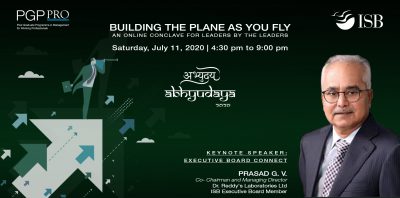
“Leadership context changes based on the phase the company is in.”- Prasad G.V., Co-Chairman and Managing Director, Dr Reddy’s
(Prasad G.V., Co-Chairman and Managing Director of Dr Reddy’s Laboratories, is also a board member at ISB. He recently shared his Dr Reddy’s journey and the leadership lessons he learnt along the way with PGPpro students through an online webinar. Here are some excerpts from his talk)
Prasad G.V. joined Dr Reddy’s in 1990, “when there was a sudden change in the organisation, the co-founders and CEOs of one of the group company left. The size of the company was around 20-25 million dollars approximately, and it was a 25-30 million dollar at a group level. The company was run by Dr Reddy, the co-founder himself, but it was a very entrepreneurial company at that time; it was just getting into the growth phase when this change happened, and a lot of people, around 2/3rd of the company, left along with the co-founder. So I was parachuted into this job at the age of 30, and I was parachuted into the CEO role. It was a small company, and my very first experience was to stabilise the company. It was a period of uncertainty, it was a period of a lot of turmoil, but it gave me my purpose in life really, which is to build an organisation that is strong, sustainable, and can thrive through change.”
Describing his long journey, he mentions the stages the organisation experienced: “I went through many phases in the organisation, in the first few years it was about making the organisation viable, making sure it’s on a strong platform financially, and then globalisation, growth, and then, of course, institutionalisation. Along the way, we lived our purpose of creating affordable products for the world: Generics, and of course, innovations to find solutions to the unmet medical needs.”
“The 3 distinct phases that I would like to put the company in are 1) The birth of the company, 2) viability, and of course, 3) establishing itself as an entity. The leadership context also changes with each phase. The 2nd phase is about growth and maturity, and the 3rd stage is about institutionalisation and renewal, and that’s probably the phase we have been in the last 10-15 years”, Mr Prasad clarifies.
He goes on to share insights on the role of leadership during phase 1: “At this point entrepreneurship becomes very important, taking decisions on the fly, being agile, understanding where the money is, understanding your obligations, having the financial resources to make ends meet. Understanding what problem the company is solving for the society, what societal need is the company addressing. In our case, we were clear from day 1 that it would be affordability, making products affordable, so that many more people can be treated.”
Dr Reddy’s moved to the phase of growth and scale post-90s. “At that point, suddenly when you are exposed to international competition, we had to look at our own competencies, skills, talent, and also the processes to handle scale. So the next stage was about growth, about driving internationalisation, driving the professional journey of the organisation, so that we could get many more leaders and build talent to handle the scale. And of course, at that point, as we were competing for the global level, we had to improve our skills in terms of quality, in terms of regulatory affairs, legal skills, to handle intellectual property, litigations and all of that. The next decade or decade and a half were spent in building skills, building competence and of course attracting talent. This meant moving from a largely local, entrepreneur-driven company to a more professional organisation where we would attract leadership talent from outside the industry and professional schools. And this involved a shift in culture from being a top-driven entrepreneurial company to a culture that was more empowered; from a secretive preserving-our-technology edge to a more open, transparent culture. As we grew we needed to fund the growth, so we had to raise capital, and we went to the capital markets in India as well as in Europe and US, and ultimately, we got listed on the NYSE in ~ 2001.”
“From that phase, we moved to the next phase which is really institution-building and making the organisation independent of individuals and able to renew itself, and I think we are still in that phase of institutionalisation and renewal”, he shares, finally stressing on the function of leadership building in phase 3. “In this stage, we had to move from a focus on individuals to focus on processes, governance, creating consistency, repeatability, and a commitment to excellence. This again required a different approach towards management and leadership. It also meant changing organisational structures, moving from a functional organisation to a business-led organisation so that we could have many more leaders who could take end to end responsibility.”
So how did he manage the change? “We organised ourselves into distinct businesses, with the P & L responsibility shifting from the CEO level down to the business level leaders. This required different systems, different culture and a sense of accountability, and we moved from being an organisation that was a monolithic functional unit to different business units. We drove a lot of independence so that the business leaders felt empowered. They could manage P & L, and we really automated (automated) the organisation”, he shares, visibly proud of his 30 years of achievement at Dr Reddy’s and how instrumental he has been in making the company a secure, independently thriving enterprise.



